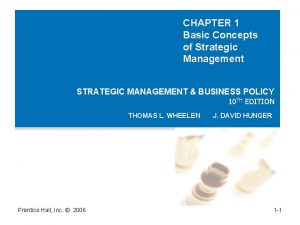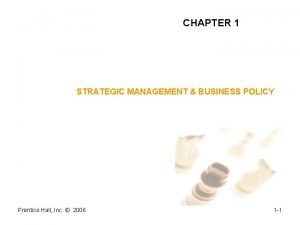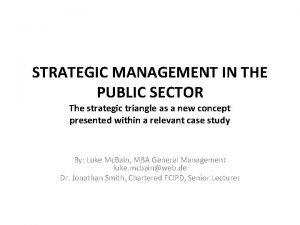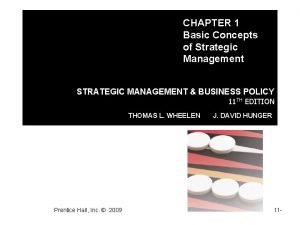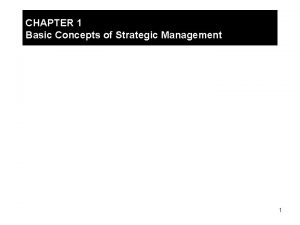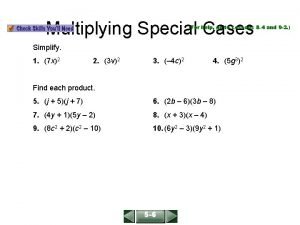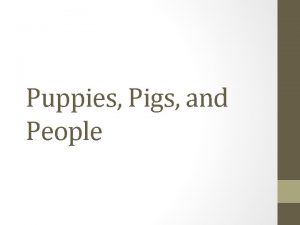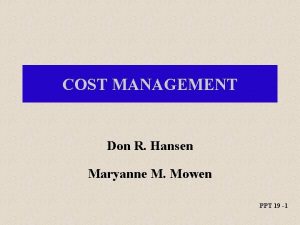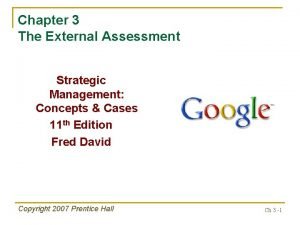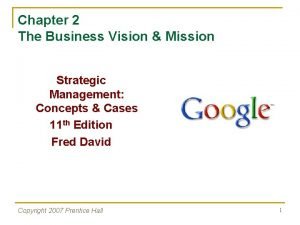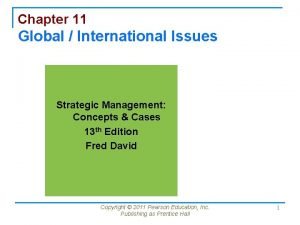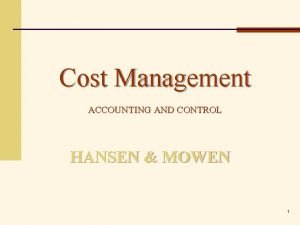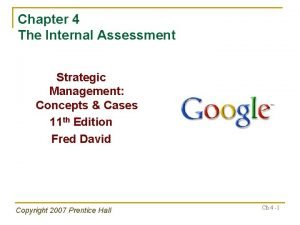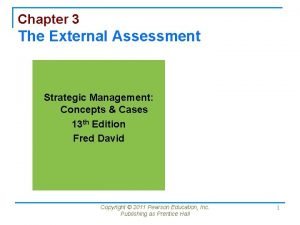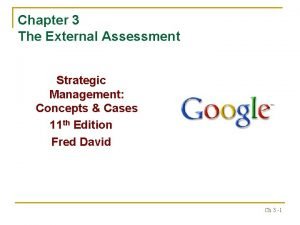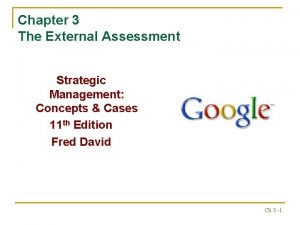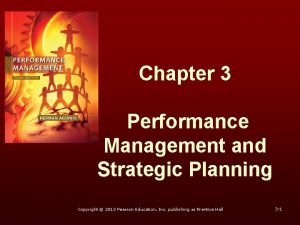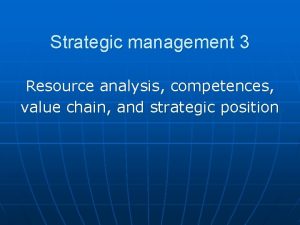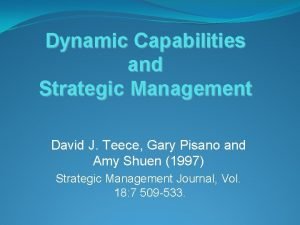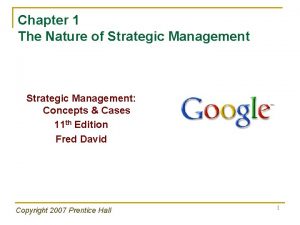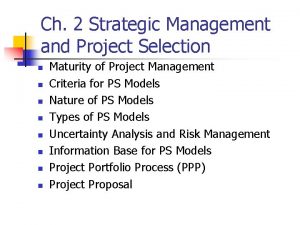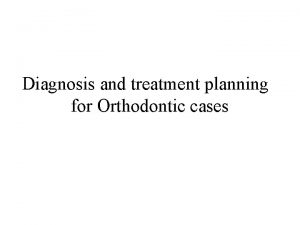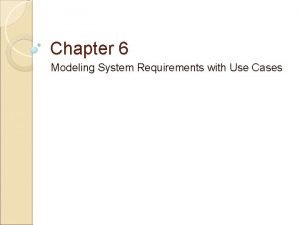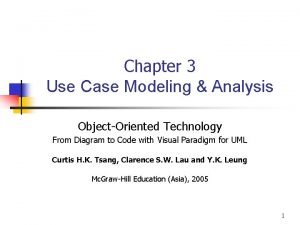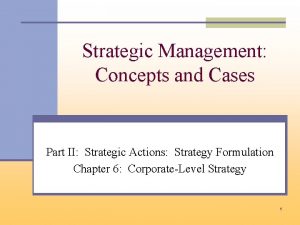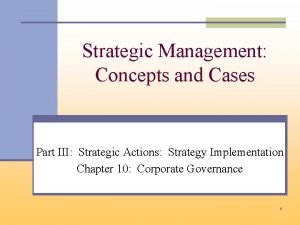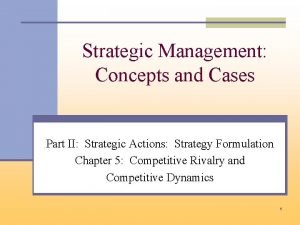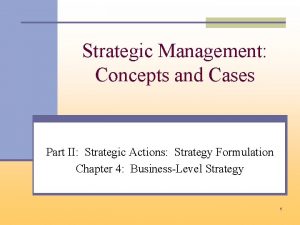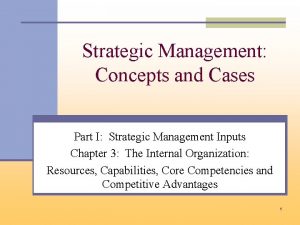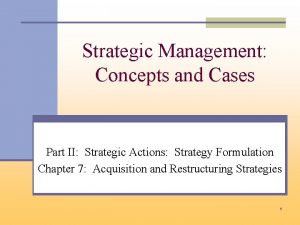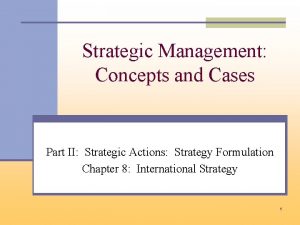Strategic Management Concepts and Cases 9 e Part




























































- Slides: 60

Strategic Management: Concepts and Cases 9 e Part III: Strategic Actions: Strategy Implementation Chapter 11: Organizational Structure and Controls © 2011 Cengage Learning. All Rights Reserved. May not be scanned, copied or duplicated, or posted to a publicly accessible website, in whole or in part.

The Strategic Management Process © 2011 Cengage Learning. All Rights Reserved. May not be scanned, copied or duplicated, or posted to a publicly accessible website, in whole or in part.

Chapter 11: Organizational Structure (OS) and Controls • Overview: Six content areas – Define OS and controls and differences between strategic and financial controls – Describe relationship between strategy & structure – Describe the functional structures used to implement business-level strategies – Three versions of multi-divisional (M-form) structure for different diversification strategies – OS for implementation of three international strategies – Strategic networks and their implementation © 2011 Cengage Learning. All Rights Reserved. May not be scanned, copied or duplicated, or posted to a publicly accessible website, in whole or in part.

Cisco’s Evolution of Strategy and Structure • Early Growth – Focus on network equipment that enabled voice, video, and data to travel across computer networks – Three lines of business • Each line was a self-contained businesses with its own functional areas • Post-Internet Bubble Burst – Reorganized into 11 technology divisions – Sales remained organized around original three lines – Evolved into hardware, software, and services supplier • 2008 Recession – Expanded into nontraditional businesses for revenue – Once again changed its structure © 2011 Cengage Learning. All Rights Reserved. May not be scanned, copied or duplicated, or posted to a publicly accessible website, in whole or in part.

Introduction • All firms use at least one business-level strategy • Once selected, strategies are NOT implemented in a vacuum! • Organizational structure and controls provide framework within which strategies are used © 2011 Cengage Learning. All Rights Reserved. May not be scanned, copied or duplicated, or posted to a publicly accessible website, in whole or in part.

Chapter 11: Organizational Structure (OS) and Controls • Overview: Six content areas – Define OS and controls and differences between strategic and financial controls – Describe relationship between strategy & structure – Describe the functional structures used to implement business-level strategies – Three versions of multi-divisional (M-form) structure for different diversification strategies – OS for implementation of three international strategies – Strategic networks and their implementation © 2011 Cengage Learning. All Rights Reserved. May not be scanned, copied or duplicated, or posted to a publicly accessible website, in whole or in part.

Organizational Structure (OS) & Controls (OC) • Organizational Structure (OS) – Specifies firm’s formal reporting relationships, procedures, controls, authority & decision-making processes (i. e. , work to be done and how to do it!) – Effective use of firm’s strategies facilitated when structure is properly aligned • Structural stability: Capacity firm requires to consistently and predictably manage its daily work routines • Structural flexibility: Opportunity to explore competitive advantages firm will need to be successful in the future – Pioneer Alfred Chandler found organizations change their structures when inefficiencies force them to do so © 2011 Cengage Learning. All Rights Reserved. May not be scanned, copied or duplicated, or posted to a publicly accessible website, in whole or in part.

Organizational Structure & Controls (Cont’d) • Organizational Controls (OC) – Guide the use of strategy, indicate how to compare actual results with expected results, and suggest corrective actions to take when the difference is unacceptable – Two types include strategic and financial © 2011 Cengage Learning. All Rights Reserved. May not be scanned, copied or duplicated, or posted to a publicly accessible website, in whole or in part.

Organizational Structure & Controls (Cont’d) • Organizational Controls (OC) – 1. Strategic controls: largely subjective criteria intended to verify that the firm is using appropriate strategies for the conditions in the external environment and the company’s competitive advantages • Concerned with what firm might do vs. what it can do • Used to evaluate degree to which firm focuses on the requirement to implement strategies (i. e. , SUB: primary and support activities; corporate level: knowledge, markets & technologies across businesses) • Focus on the content of strategic actions • Encourage decisions that incorporate moderate and acceptable levels of risk © 2011 Cengage Learning. All Rights Reserved. May not be scanned, copied or duplicated, or posted to a publicly accessible website, in whole or in part.

Organizational Structure & Controls • Organizational Controls (OC) (Cont’d) – 2. Financial controls • Objective criteria used to measure firm’s performance against previously established quantitative standards (used for unrelated diversification) • Focus on short-term financial outcomes • Produce risk-averse managerial decisions © 2011 Cengage Learning. All Rights Reserved. May not be scanned, copied or duplicated, or posted to a publicly accessible website, in whole or in part.

Chapter 11: Organizational Structure (OS) and Controls • Overview: Six content areas – Define OS and controls and differences between strategic and financial controls – Describe relationship between strategy & structure – Describe the functional structures used to implement business-level strategies – Three versions of multi-divisional (M-form) structure for different diversification strategies – OS for implementation of three international strategies – Strategic networks and their implementation © 2011 Cengage Learning. All Rights Reserved. May not be scanned, copied or duplicated, or posted to a publicly accessible website, in whole or in part.

Strategy vs. Structure: Relationships • Reciprocal relationship • Implies change to one causes change in the other • “Research shows strategy has a much more important influence on structure than the reverse. ” © 2011 Cengage Learning. All Rights Reserved. May not be scanned, copied or duplicated, or posted to a publicly accessible website, in whole or in part.

Strategy vs. Structure: Evolutionary Patterns • Chandler found firms tend to grow in a predictable pattern, including the areas of volume, geography, integration (horizontal & vertical) & product/ business diversification – Growth pattern implies structural changes! • Several structure forms are used to implement strategies, including: – 1. Simple – 2. Functional – 3. Multidivisional © 2011 Cengage Learning. All Rights Reserved. May not be scanned, copied or duplicated, or posted to a publicly accessible website, in whole or in part.

Strategy and Structure Growth Pattern © 2011 Cengage Learning. All Rights Reserved. May not be scanned, copied or duplicated, or posted to a publicly accessible website, in whole or in part.

Strategy vs. Structure: Evolutionary Patterns (Cont’d) • Three main structures – 1. Simple • Owner-manager makes all major decisions and monitors all activities, staff acts as extension of manager's supervisory authority • Few rules, limited task specialization, unsophisticated technology system • As firm grows more complex, need to add layers and controls © 2011 Cengage Learning. All Rights Reserved. May not be scanned, copied or duplicated, or posted to a publicly accessible website, in whole or in part.

Strategy vs. Structure: Evolutionary Patterns (Cont’d) • Three main structures (Cont’d) – 2. Functional • CEO and a limited corporate staff make all decisions, with functional line managers in dominant organizational areas • Allows functional specialization resulting in active knowledge sharing in each functional area • Can negatively affect communication and coordination among those representing different organizational functions • When changing from a simple to functional structure need to focus on value-destroying bureaucratic procedures © 2011 Cengage Learning. All Rights Reserved. May not be scanned, copied or duplicated, or posted to a publicly accessible website, in whole or in part.

Strategy vs. Structure: Evolutionary Patterns (Cont’d) • Three main structures (Cont’d) – 3 A. Multidivisional (M-form) structure • Operating divisions each represent a separate business or profit center in which the top corporate officer delegates responsibilities for day-to-day operations and business-unit strategies to division managers • Ties together several operating divisions, each representing a separate business or profit center to which responsibility for daily operations and business-unit strategy is delegated © 2011 Cengage Learning. All Rights Reserved. May not be scanned, copied or duplicated, or posted to a publicly accessible website, in whole or in part.

Strategy vs. Structure: Evolutionary Patterns (Cont’d) • Three main structures – Multidivisional (M-form) structure (Cont’d) • It enables corporate officers to more accurately monitor the performance of each business, which simplifies the problem of control • It facilitates comparisons between divisions, which improves resource allocation process • It stimulates managers of poorly performing divisions to look for ways of improving performance © 2011 Cengage Learning. All Rights Reserved. May not be scanned, copied or duplicated, or posted to a publicly accessible website, in whole or in part.

Strategy vs. Structure: Evolutionary Patterns (Cont’d) • No one structure (simple, functional or multidivisional) is superior to the others © 2011 Cengage Learning. All Rights Reserved. May not be scanned, copied or duplicated, or posted to a publicly accessible website, in whole or in part.

Strategy vs. Structure: Evolutionary Patterns (Cont’d) • Business-level strategies & functional structure matches for implementing strategies: – 1. Cost leadership – 2. Differentiation – 3. Integrated cost leadership/differentiation • Structural characteristics drive different forms of organizational structures – 1. Specialization – 2. Centralization – 3. Formalization © 2011 Cengage Learning. All Rights Reserved. May not be scanned, copied or duplicated, or posted to a publicly accessible website, in whole or in part.

Strategy vs. Structure: Evolutionary Patterns (Cont’d) • Structural characteristics defined – 1. Specialization • Type and number of jobs required to do work – 2. Centralization • Degree to which decision-making authority is retained at higher managerial levels – 3. Formalization • Degree to which formal rules and procedures govern work © 2011 Cengage Learning. All Rights Reserved. May not be scanned, copied or duplicated, or posted to a publicly accessible website, in whole or in part.

Functional Structure for Implementing a Cost Leadership Strategy © 2011 Cengage Learning. All Rights Reserved. May not be scanned, copied or duplicated, or posted to a publicly accessible website, in whole or in part.

Strategy vs. Structure: Evolutionary Patterns (Cont’d) • Matches between business-level strategies and functional structure to implement them: – 1. Cost leadership & 5 Forces of Competition • Low-cost position is a valuable defense against rivals • Powerful customers can demand reduced prices • Costs leaders are in a position to absorb supplier price increases and relationship demands, and to force suppliers to hold down their prices • Continuously improving levels of efficiency and cost reduction can be difficult to replicate and serve as significant entry barriers to potential competitors • Cost leaders hold an attractive position in terms of product substitutes, with the flexibility to lower prices to retain customers © 2011 Cengage Learning. All Rights Reserved. May not be scanned, copied or duplicated, or posted to a publicly accessible website, in whole or in part.

Strategy vs. Structure: Evolutionary Patterns (Cont’d) • Matches between business-level strategies and functional structure to implement them: – 1. Cost leadership and the functional structure • Simple reporting relationships • Few decision-making and authority layers • Centralized corporate staff • Strong operational focus on process improvements • Low-cost culture • Centralized staff decision-making authority • Jobs specialization • Highly formalized rules and procedures © 2011 Cengage Learning. All Rights Reserved. May not be scanned, copied or duplicated, or posted to a publicly accessible website, in whole or in part.

Strategy vs. Structure: Evolutionary Patterns (Cont’d) • Matches between business-level strategies and functional structure to implement them: – 1. Cost leadership strategy risks • Processes can become obsolete • Focus on cost reductions can come at the expense of understanding customer perceptions and needs • Strategy could be imitated, requiring the firm to increase the value offered to retain customers © 2011 Cengage Learning. All Rights Reserved. May not be scanned, copied or duplicated, or posted to a publicly accessible website, in whole or in part.

Functional Structure for Implementing a Differentiation Strategy © 2011 Cengage Learning. All Rights Reserved. May not be scanned, copied or duplicated, or posted to a publicly accessible website, in whole or in part.

Strategy vs. Structure: Evolutionary Patterns (Cont’d) • Matches between business-level strategies and functional structure to implement them : – 2. Differentiation strategy • Integrated set of actions designed by a firm to produce or deliver goods or services at an acceptable cost that customers perceive as being different in ways that are important to them • Target customers – perceived product value • Customized products – differentiating on as many features as possible: – Unusual features, responsive customer service, rapid product innovations, technological leadership, perceived prestige and status, different tastes, engineering design, performance © 2011 Cengage Learning. All Rights Reserved. May not be scanned, copied or duplicated, or posted to a publicly accessible website, in whole or in part.

Strategy vs. Structure: Evolutionary Patterns (Cont’d) • Matches between business-level strategies and functional structure to implement them : – 2. Differentiation & 5 Forces of Competition • Customer loyalty: the most valuable defense against rivals • Unique products reduce customer sensitivity to raised prices • High margins (for differentiated products) insulate firm from supplier influence • Significant entry barriers: customer loyalty & product uniqueness • Firms with customers loyal to their products are positioned effectively against product substitutes © 2011 Cengage Learning. All Rights Reserved. May not be scanned, copied or duplicated, or posted to a publicly accessible website, in whole or in part.

Strategy vs. Structure: Evolutionary Patterns (Cont’d) • Matches between business-level strategies and functional structure to implement them : – 2. Differentiation and functional structure • Complex and flexible reporting relationships • Cross-functional product development teams • Strong focus on marketing and product R&D • Development-oriented culture • Decentralized decision making • Broad job descriptions • Informal rules and procedures © 2011 Cengage Learning. All Rights Reserved. May not be scanned, copied or duplicated, or posted to a publicly accessible website, in whole or in part.

Strategy vs. Structure: Evolutionary Patterns (Cont’d) • Matches between business-level strategies and functional structure to implement them : – 2. Differentiation strategy risks • Price differential for differentiated product may be perceived as too large • Firms’ means of differentiation may cease to provide value for which customers are willing to pay (successful rival imitation) • Experience can narrow customers' perceptions of the value of a product's differentiated features • Counterfeit goods might appear in the marketplace © 2011 Cengage Learning. All Rights Reserved. May not be scanned, copied or duplicated, or posted to a publicly accessible website, in whole or in part.

Strategy vs. Structure: Evolutionary Patterns (Cont’d) • Matches between business-level strategies and functional structure to implement them : – 3. Integrated cost leadership/differentiation strategy • These firms may sell products that create value because of relatively low price and reasonable sources of differentiation • Difficult to implement, but frequently used in the global economy • Challenge due to primary/support activities • Need to successfully combine specialization, formalization and centralization © 2011 Cengage Learning. All Rights Reserved. May not be scanned, copied or duplicated, or posted to a publicly accessible website, in whole or in part.

Strategy vs. Structure: Evolutionary Patterns (Cont’d) • Matches between corporate-level strategies and multidivisional structure – 3 forms © 2011 Cengage Learning. All Rights Reserved. May not be scanned, copied or duplicated, or posted to a publicly accessible website, in whole or in part.

Three Variations of the Multidivisional Structure © 2011 Cengage Learning. All Rights Reserved. May not be scanned, copied or duplicated, or posted to a publicly accessible website, in whole or in part.

Cooperative Form of the Multidivisional Structure for Implementing a Related Constrained Strategy © 2011 Cengage Learning. All Rights Reserved. May not be scanned, copied or duplicated, or posted to a publicly accessible website, in whole or in part.

Strategy vs. Structure: Evolutionary Patterns (Cont’d) • Matches between corporate-level strategies & multidivisional structure: Cooperative form/related constrained strategy – Cooperative form: organizational structure using horizontal integration to bring about interdivisional cooperation – Divisions formed around products, markets or both – All of the divisions share one or more corporate strengths – Interdivisional sharing depends on cooperation – Links resulting from effective integration mechanisms support sharing of both tangible and intangible resources – Centralization is one integrating mechanism that can be used to link activities among divisions, allowing firms to exploit common strengths and share competencies © 2011 Cengage Learning. All Rights Reserved. May not be scanned, copied or duplicated, or posted to a publicly accessible website, in whole or in part.

Strategy vs. Structure: Evolutionary Patterns (Cont’d) • Matches between corporate-level strategies & multidivisional structure: Cooperative form/related constrained strategy (cont’d) – Success influenced by how well information is processed among divisions – Success can be influenced by managerial commitment levels and the response to some lost managerial autonomy – Matrix organization may evolve • organizational structure in which a dual structure combines both functional specialization and business product or project specialization © 2011 Cengage Learning. All Rights Reserved. May not be scanned, copied or duplicated, or posted to a publicly accessible website, in whole or in part.

SBU Form of the Multidivisional Structure for Implementing a Related Linked Strategy © 2011 Cengage Learning. All Rights Reserved. May not be scanned, copied or duplicated, or posted to a publicly accessible website, in whole or in part.

Strategy vs. Structure: Evolutionary Patterns (Cont’d) • Matches between corporate-level strategies & multidivisional structure: SBU form/related linked strategy – Related linked: Firms that share fewer resources and assets among their businesses, concentrating on the transfer of knowledge and competencies among the businesses – Strategic Business-Unit (SBU) Form: multidivisional organization structure with three levels to support the implementation diversification strategy • 1. Corporate headquarters • 2. Strategic Business Units (SBUs) • 3. SBU division © 2011 Cengage Learning. All Rights Reserved. May not be scanned, copied or duplicated, or posted to a publicly accessible website, in whole or in part.

Strategy vs. Structure: Evolutionary Patterns (Cont’d) • Matches between corporate-level strategies & multidivisional structure: SBU form/related linked strategy – SBU Form (Cont’d) • Divisions within each SBU are related in terms of shared products and/or markets • Divisions of one SBU have little in common with divisions of other SBUs • Divisions within each SBU share product or market competencies to develop economies of scope • Integrations used in cooperative form are equally effective for the SBU form • Each SBU is a profit center • Financial controls are more vital for evaluating performance © 2011 Cengage Learning. All Rights Reserved. May not be scanned, copied or duplicated, or posted to a publicly accessible website, in whole or in part.

Competitive Form of the Multidivisional Structure for Implementing an Unrelated Strategy © 2011 Cengage Learning. All Rights Reserved. May not be scanned, copied or duplicated, or posted to a publicly accessible website, in whole or in part.

Strategy vs. Structure: Evolutionary Patterns (Cont’d) • Matches between corporate-level strategies & multidivisional structure: Competitive form/unrelated diversification – Competitive form defined: organizational structure in which the firm's divisions are completely independent – Divisions do not share common corporate strengths – Integration devices not developed to coordinate activities across divisions – Efficient capital markets in unrelated strategies require organizational arrangements that emphasize divisional competition rather than cooperation – Specific performance expectations and accountability for independent divisions stimulate internal competition for future resources © 2011 Cengage Learning. All Rights Reserved. May not be scanned, copied or duplicated, or posted to a publicly accessible website, in whole or in part.

Strategy vs. Structure: Evolutionary Patterns (Cont’d) • Matches between corporate-level strategies and multidivisional structure: Competitive form/unrelated diversification (Cont’d) – Headquarters maintains a distant relationship to avoid intervention in divisional affairs – Strategic controls are used to monitor performance relative to targeted returns – Headquarters remains responsible for cash flow allocation, performance appraisal, resource allocation, and the legal aspects related to acquisitions © 2011 Cengage Learning. All Rights Reserved. May not be scanned, copied or duplicated, or posted to a publicly accessible website, in whole or in part.

Chapter 11: Organizational Structure (OS) and Controls • Overview: Six content areas – Define OS and controls and differences between strategic and financial controls – Describe relationship between strategy & structure – Describe the functional structures used to implement business-level strategies – Three versions of multi-divisional (M-form) structure for different diversification strategies – OS for implementation of three international strategies – Strategic networks and their implementation © 2011 Cengage Learning. All Rights Reserved. May not be scanned, copied or duplicated, or posted to a publicly accessible website, in whole or in part.

Worldwide Geographic Area Structure for Implementing a Multidomestic Strategy © 2011 Cengage Learning. All Rights Reserved. May not be scanned, copied or duplicated, or posted to a publicly accessible website, in whole or in part.

International Strategy and Worldwide Structure (Cont’d) • Three Primary International Strategies: • 1. Worldwide geographic area structure to implement the Multidomestic Strategy – Multidomestic Strategy: international strategy in which strategic and operating decisions are decentralized to the strategic business-unit (SBU) in each country to allow the units to tailor products to local markets – Worldwide Geographic Area Structure: organizational structure emphasizing national interests and facilitates efforts to satisfy local or cultural differences (used to implement the multidomestic strategy) – Focuses on variations of competition within each country © 2011 Cengage Learning. All Rights Reserved. May not be scanned, copied or duplicated, or posted to a publicly accessible website, in whole or in part.

International Strategy and Worldwide Structure (Cont’d) • Three Primary International Strategies: • 1. Worldwide geographic area structure to implement the Multidomestic Strategy (Cont’d) – Customizes products to meet specific needs and preferences of local customers – Decentralizes the firm's strategic and operating decisions to business units in each country – Takes steps to isolate the firm from global competitive forces • Establish protected market positions • Compete in industry segments most affected by differences among local countries – Deals with uncertainty due to differences across markets © 2011 Cengage Learning. All Rights Reserved. May not be scanned, copied or duplicated, or posted to a publicly accessible website, in whole or in part.

Worldwide Product Divisional Structure for Implementing a Global Strategy © 2011 Cengage Learning. All Rights Reserved. May not be scanned, copied or duplicated, or posted to a publicly accessible website, in whole or in part.

International Strategy and Worldwide Structure (Cont’d) • Three Primary International Strategies: • 2. Worldwide product divisional structure to implement Global Strategy – Global Strategy: International strategy whereby firm offers standardized products across country markets, with the competitive strategy being dictated by the home office – Worldwide Product Divisional Structure: Organizational structure with centralized decision-making authority in the WW division headquarters to coordinate and integrate decisions and actions among divisional business units (used to implement the global strategy) – Facilitated by improved global accounting and financial reporting standards © 2011 Cengage Learning. All Rights Reserved. May not be scanned, copied or duplicated, or posted to a publicly accessible website, in whole or in part.

International Strategy and Worldwide Structure (Cont’d) • Three Primary International Strategies: • 2. Worldwide product divisional structure to implement Global Strategy (Cont’d) – Emphasizes economies of scale – Centralizes the firm's strategic and operating decisions at the home office – Involves SBUs operating in each country that are interdependent – Home office attempts to achieve integration across SBUs, adding management complexity – Produces lower risk – Is less responsive to local market opportunities – Offers less effective learning processes due to the pressure to conform and standardize © 2011 Cengage Learning. All Rights Reserved. May not be scanned, copied or duplicated, or posted to a publicly accessible website, in whole or in part.

Hybrid Form of the Combination Structure for Implementing a Transnational Strategy © 2011 Cengage Learning. All Rights Reserved. May not be scanned, copied or duplicated, or posted to a publicly accessible website, in whole or in part.

International Strategy and Worldwide Structure (Cont’d) • Three Primary International Strategies: • 3. Combination structure to implement the Transnational Strategy – Transnational Strategy: International strategy through which the firm seeks to achieve both global efficiency and local responsiveness; usually implemented through global matrix structure and hybrid global design – Flexible Coordination: Building a shared vision and individual commitment through an integrated network – Combination Structure: Organizational structure in which characteristics and mechanisms are drawn from both the worldwide geographic area structure and the worldwide product divisional structure (used to implement transnational strategy) © 2011 Cengage Learning. All Rights Reserved. May not be scanned, copied or duplicated, or posted to a publicly accessible website, in whole or in part.

International Strategy and Worldwide Structure (Cont’d) • Three Primary International Strategies: • 3. Combination structure to implement the Transnational Strategy (Cont’d) – Assets and operations may be centralized/decentralized – Functions may be integrated/nonintegrated – Relationships may be formal/informal – Coordination mechanisms may leverage efficiency/flexibility – Mandates to subsidiaries may be global/specializedcontribution/ localized-implementation – There are competing objectives when a worldwide combination structure is used to implement a transnational strategy © 2011 Cengage Learning. All Rights Reserved. May not be scanned, copied or duplicated, or posted to a publicly accessible website, in whole or in part.

Chapter 11: Organizational Structure (OS) and Controls • Overview: Six content areas – Define OS and controls and differences between strategic and financial controls – Describe relationship between strategy & structure – Describe the functional structures used to implement business-level strategies – Three versions of multi-divisional (M-form) structure for different diversification strategies – OS for implementation of three international strategies – Strategic networks and their implementation © 2011 Cengage Learning. All Rights Reserved. May not be scanned, copied or duplicated, or posted to a publicly accessible website, in whole or in part.

A Strategic Network © 2011 Cengage Learning. All Rights Reserved. May not be scanned, copied or duplicated, or posted to a publicly accessible website, in whole or in part.

Strategic Network • Matches between cooperative strategies and network structures – Network strategy: Partners form several alliances in order to improve the performance of the alliance network itself through cooperative endeavors – Strategic network: Group of firms that form around the core to create value to participating in multiple cooperative arrangements • At core: Strategic Center Firm which has 4 primary tasks © 2011 Cengage Learning. All Rights Reserved. May not be scanned, copied or duplicated, or posted to a publicly accessible website, in whole or in part.

Strategic Network (Cont’d) • Strategic Center Firm’s primary tasks – 1. – 2. – 3. – 4. Strategic outsourcing Competencies Technology Race to learn © 2011 Cengage Learning. All Rights Reserved. May not be scanned, copied or duplicated, or posted to a publicly accessible website, in whole or in part.

Implementing Business-level Cooperative Strategies • Business-level complementary alliances – Vertical: partnering firms share their resources and capabilities from different stages of the value chain to create a competitive advantage. – Horizontal: partnering firms share resources and capabilities from the same stage of the value chain to create a competitive advantage - commonly used for long-term product development and distribution opportunities © 2011 Cengage Learning. All Rights Reserved. May not be scanned, copied or duplicated, or posted to a publicly accessible website, in whole or in part.

Implementing Corporate-level Cooperative Strategies • Used to facilitate product & market diversification – i. e. , Franchising: contractual relationship to describe and control the sharing of its resources and capabilities with partners • Allows firms to use its competencies to extend or diversity product or market reach, without completing a merger or acquisition – Knowledge embedded in corporate-level cooperative strategies facilitates synergy © 2011 Cengage Learning. All Rights Reserved. May not be scanned, copied or duplicated, or posted to a publicly accessible website, in whole or in part.

A Distributed Strategic Network © 2011 Cengage Learning. All Rights Reserved. May not be scanned, copied or duplicated, or posted to a publicly accessible website, in whole or in part.

Implementing International Cooperative Strategies • Strategic networks formed to implement cooperative strategies resulting in firm competing in several different countries – Distributed strategic networks: Organizational structure used to manage international cooperative strategies • Several regional strategic center firms are included in the distributed network to manage partner firms’ multiple cooperative arrangements © 2011 Cengage Learning. All Rights Reserved. May not be scanned, copied or duplicated, or posted to a publicly accessible website, in whole or in part.
 Criminal cases vs civil cases
Criminal cases vs civil cases Io model strategic management
Io model strategic management Analysing the 6 strategic options megxit
Analysing the 6 strategic options megxit Business ethics and
Business ethics and Basic concepts of strategic management
Basic concepts of strategic management Basic concepts of strategic management
Basic concepts of strategic management Basic concepts of strategic management
Basic concepts of strategic management Basic concept of strategic management
Basic concept of strategic management Public sector strategic management
Public sector strategic management Why is it not advisable to pursue many strategies at once
Why is it not advisable to pursue many strategies at once Basic concepts of strategic management
Basic concepts of strategic management A strategic decision is rare, consequential, and directive.
A strategic decision is rare, consequential, and directive. 8-4 multiplying special cases form g
8-4 multiplying special cases form g Strategic complements
Strategic complements Analyzing accounting concepts and practices chapter 2
Analyzing accounting concepts and practices chapter 2 Eb = p x a x t
Eb = p x a x t Haley strategic family therapy
Haley strategic family therapy Strategic fit vs strategic intent
Strategic fit vs strategic intent Business process management cases
Business process management cases Norcross puppies pigs
Norcross puppies pigs Part part whole addition
Part part whole addition Unit ratio definition
Unit ratio definition Brainpop ratios
Brainpop ratios Technical description meaning
Technical description meaning Standard bar parts and layout
Standard bar parts and layout The part of a shadow surrounding the darkest part
The part of a shadow surrounding the darkest part Two way anova minitab 17
Two way anova minitab 17 The strategy making strategy executing process
The strategy making strategy executing process Social responsibility and ethics in strategic management
Social responsibility and ethics in strategic management Strategic cost management hansen and mowen
Strategic cost management hansen and mowen Internal and external assessment in strategic management
Internal and external assessment in strategic management Chapter 3 ethics and social responsibility
Chapter 3 ethics and social responsibility Mission in strategic management
Mission in strategic management Global issues in strategic management
Global issues in strategic management Visionary leadership and strategic management
Visionary leadership and strategic management Scope of strategic management
Scope of strategic management Global retailing strategies
Global retailing strategies Slidetodoc.com
Slidetodoc.com Characteristics of strategic management
Characteristics of strategic management Integrating strategy and culture in internal assessment
Integrating strategy and culture in internal assessment External assessment in strategic management
External assessment in strategic management Competition in virtually all industries is
Competition in virtually all industries is Internal and external assessment in strategic management
Internal and external assessment in strategic management Internal and external assessment in strategic management
Internal and external assessment in strategic management Competition in virtually all industries is
Competition in virtually all industries is Chapter 3 the external assessment
Chapter 3 the external assessment Chapter 3 external assessment
Chapter 3 external assessment Maylor four stage model
Maylor four stage model Mergers in strategic management
Mergers in strategic management Weighted factor scoring model
Weighted factor scoring model Performance management and strategic planning
Performance management and strategic planning Why is strategic management important
Why is strategic management important Resources and capabilities in strategic management
Resources and capabilities in strategic management Dynamic capabilities and strategic management
Dynamic capabilities and strategic management David teece dynamic capabilities and strategic management
David teece dynamic capabilities and strategic management Business ethics in strategic management
Business ethics in strategic management Strategic management and project selection
Strategic management and project selection Malocclusion
Malocclusion Use case narratives
Use case narratives Global marketing contemporary theory practice and cases
Global marketing contemporary theory practice and cases Use case description
Use case description




